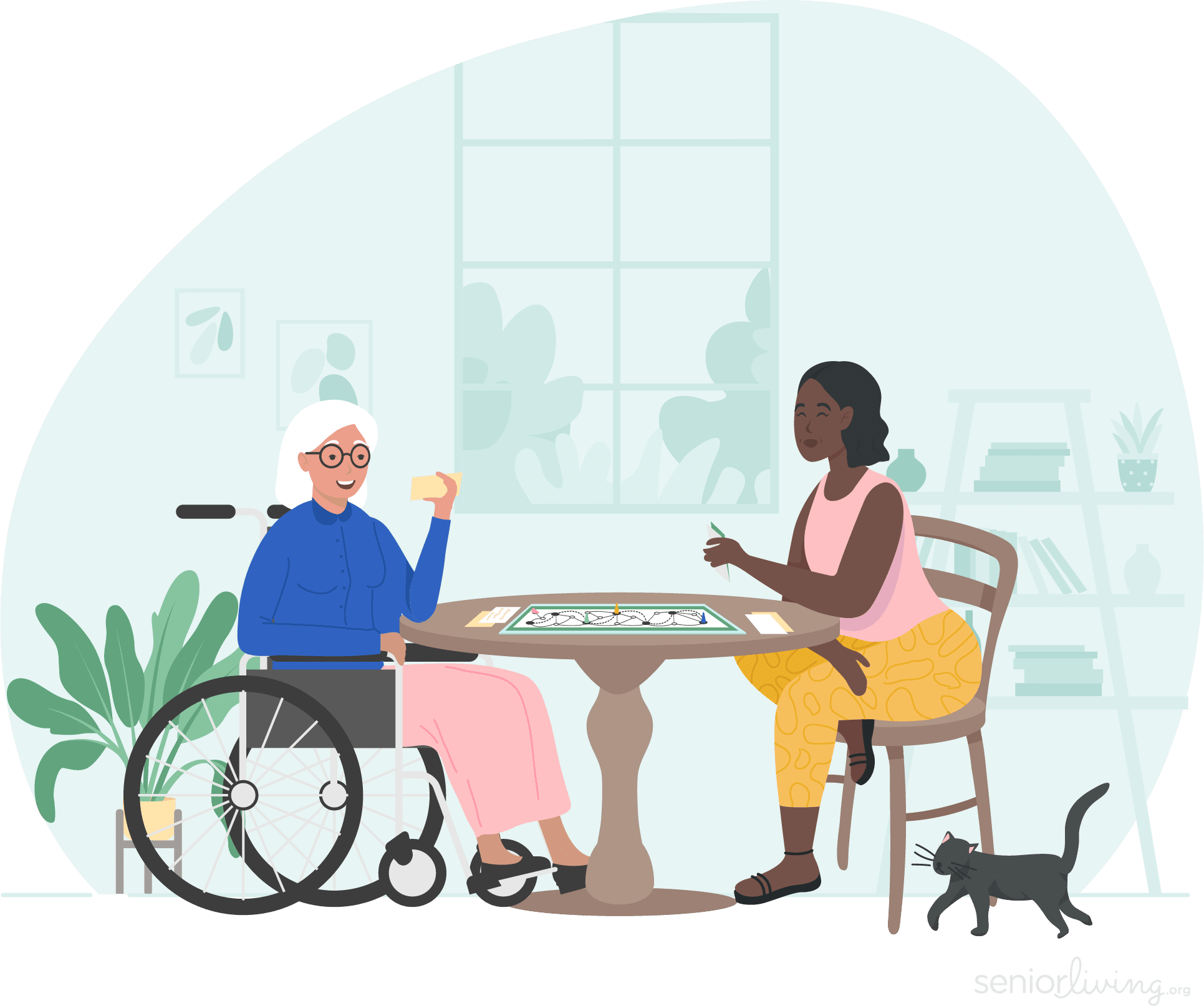55-Plus Communities and Apartments
A 2025 Guide to Finding 55-Plus Senior Living Communities Near You
SeniorLiving.org is supported by commissions from providers listed on our site. Read our Editorial Guidelines
Find 55-Plus Senior Living Communities Near You
Join 1,019,247 Seniors Who've Searched for Housing Communities on SeniorLiving.org.
Or Call: (855) 241-1699Find 55-Plus Senior Living Communities Near You
The concept of a 55-plus senior living community is simple: people 55 or older live in a planned community with a variety of amenities that cater to seniors. Residents usually live an active and healthy lifestyle, and the community services reflect their specific needs.
There are a wide variety of 55-plus communities that offer different experiences and amenities. Some communities may require a certain number of residents to be 55 or older, leaving open the possibility that young families may become your neighbors. Deciding if a 55-plus community is right for you is like any other major decision. You’ll need to do some research, explore your options, recognize potential pitfalls, and, perhaps most importantly, tour the communities you’re interested in.
In this guide, we’ll cover the different types of 55-plus communities and what you can expect there, average costs, how to decide if a community is right for you, and more!
Table of Contents
What Is a 55-Plus Community?
A 55-plus community is a location designed to accommodate people who are at least 55 years old. The atmosphere, layout, and amenities are designed for the needs of this age group, rather than, for example, young families. The area may have very specific stipulations on who can live in the community to cater to residents in this age group.
The Appeal of 55-Plus Communities
Why do people choose 55-plus communities? Because well-designed communities have all the residents’ needs in mind. The best 55-plus communities are located near hospitals, shopping, dining, and local attractions. Some older adults like the physical security that a community provides, whether it offers a gated neighborhood or on-site security patrols. Others like to live with peers and without children in the neighborhood. Many communities also have conveniences that many seniors may find helpful.
Another perk is that all your expenses — taxes, insurance, utilities, etc. — are wrapped up in one fee. Plus, the need to care for your property is basically eliminated — no more mowing the grass, raking leaves, or replacing a leaky gutter. In short, a 55-plus community tries to make life as simple and leisurely as possible for its residents.
Our free housing and care finder uses your unique needs to curate a list of the best options in your area.
Types of 55-Plus Communities
In general, 55-plus communities are for active adults who want to live with their peers. Many communities offer general amenities in a suburban setting, but others are more focused on a particular lifestyle or location. Here are a few examples:
- Luxury communities
- College town and university communities
- RV retirement parks
- Golf and resort communities
- Religious communities
- Active-senior communities
- Single-only communities
- Gated communities
Luxury Senior Living Communities
A luxury 55-plus community consists of high-end living arrangements for older adults with access to many luxurious amenities. The homes are generally larger with more amenities and features, but they tend to be priced significantly higher as well. Luxury communities may offer more services and onsite amenities to residents, and the higher price ensures that more affluent individuals live in the community.
University Retirement Community
One of the fastest-growing types of retirement communities is university 55-plus communities. These communities often have direct ties with local universities and colleges. They help make it possible for you to work or participate in learning activities at these locations while providing for your needs at home. Plus, if you’re interested in taking a class or learning a new skill, they may offer lessons or classes for residents.
Senior RV Parks and Retirement Communities
Some individuals prefer to be less set in stone when it comes to their living arrangements. In other words, they want to travel. An RV retirement park geared toward people over 55 is a great solution. Residents can stay as long as they like with others who share similar interests.
Resort and Golf Retirement Communities
Golf and resort communities offer a vacation-like experience for older adults. They are not open to the general public for rentals or vacation homes. Instead, they allow people over 55 to enjoy all the resort-like amenities the area has to offer. Golf communities are often on or near some of the most prestigious golf courses in their areas.
Faith-Based Retirement Communities
Many older adults prefer to live around people who share the same beliefs and values. There are a variety of religious 55-plus communities that can provide a sense of fellowship with other seniors of the same faith. These communities also offer specific religious services, an on-site chaplain, and community events for residents.
Active Retirement Communities
Active communities are just what they sound like — communities designed to encourage an active lifestyle. Some offer things like golf courses and bowling alleys, while others offer more access to hiking, biking, and swimming. The goal is to keep everyone active and entertained with sports, recreation, and a busy lifestyle as they age.
Single Retirement Communities
Single 55-plus communities allow unmarried individuals to come together in the same area. They may — but don’t always — offer opportunities for meeting others. In many cases, the goal is simply to provide residents with an opportunity to enjoy the company of other single adults.
Gated Communities for Seniors
Gated communities offer a bit more security but still have many of the same benefits and specializations as a 55-plus community. The main appeal is that the community does not allow just anyone to visit. Residents who want more privacy and fewer bothersome visitors will enjoy this type of community.
FYI: If you’re looking for help deciding which senior living community fits your needs, read our guide to choosing the best retirement community.
Amenities in 55-Plus Communities
The kinds of amenities you’ll find vary greatly from community to community. Most will have a clubhouse and exercise facilities, indoor or outdoor pools, hobby and crafts clubs, security, a gym, and maintenance. Others offer golf courses, marinas, tennis courts, on-site health care, restaurants, professional entertainment, walking trails, billiards rooms, card rooms, libraries or media centers, bocce courts, lakes for fishing, and many other lifestyle-related options. For older adults who need assistance with daily tasks, there are communities with on-site staff who can help.

SeniorLiving.org is supported by commissions from providers listed on our site. Read our Editorial Guidelines
Age-Restricted Communities and the Law
You’ll find many types of age-restricted communities, such as 55-plus, 62-plus, and 65-plus. The U.S. Department of Housing and Urban Development (HUD) and the Housing for Older Persons Act, which say housing must include at least one person who is 55 or older in at least 80 percent of occupied units, regulate these communities. According to these guidelines, one spouse can still be under the required age.
It is important to note that people under 19 cannot be permanent residents. These communities are usually designated as “age-qualified” in their marketing brochures. Some communities are marketed to a certain age group — “age-targeted” — but are not age-restrictive. That means younger couples with children are permitted to live there.
FYI: Not sure what some terms like “age-qualified” mean? Our guide to senior housing lingo can help.
Questions and Important Considerations When Choosing a 55-Plus Community
As you research and visit 55+ communities, consider the things that won’t be mentioned in brochures. Below is a list of questions to ask as you tour.
- What are your neighbors like? Do they live there all year or part-time? Are they the kind of people you’d want to have over for dinner? Do you share the same interests?
- Is the developer on solid financial ground? If there are structural issues, do they have the resources to resolve them? What if homeowners default? Can they weather that kind of storm? Ask to see a copy of their budget and profit and loss statement, which should be readily available from the homeowner’s association.
- Is there a reserve fund for maintenance? Often called a “sinking fund,” it’s money set aside for things such as roof replacement and air conditioning replacement. It’s usually a line item on the HOA’s budget.
- Who owns the land adjacent to the community? What are the plans for the land? You may not want an airport built next door.
- What rules will you have to follow? Some communities don’t allow residents to display flags of any kind, including the American flag. You typically can’t park an RV on the street or your driveway. You may not be able to paint your front door a different color or build a jungle gym in your backyard for the grandchildren. Make sure to check out what you can and can’t do by asking to see a copy of the HOA’s bylaws.
How Much Do 55-Plus Communities Cost?
There is no limit to what 55-plus communities can cost. The type of community, the size of the accommodations, and the location all play a role in the price. Some higher-end locations can be just as expensive — if not more so — as owning a home. Since you have the option to rent or own a home in a 55-plus community, both up-front and long-term costs can vary widely. The easiest way to determine costs is to research and tour local communities.
Quick Tip: Consider using a budgeting app to manage your housing costs and other expenses. Check out the five best budgeting apps for seniors.
55-Plus House Community
Some 55-plus communities are neighborhoods with walkable streets and single-family homes. This is ideal for active, healthy people who still want to have the freedom of living in a house. The cost of renting or owning a home in these communities is often higher than in a standard neighborhood, to account for additional amenities and services.
Buying a House in a 55-Plus Community
Buying a house in a 55-plus community allows you to maintain ownership of the property and land. You’ll need to meet HOA requirements, but you will still have all the same freedoms as a homeowner in any other planned community.
Renting a House in a 55-Plus Community
Some 55-plus communities offer renting options. You do not own the home, but you can live in it and enjoy the community’s amenities. This is a good option if you aren’t ready to buy or do not want a long-term commitment.
Buying an Apartment in a 55-Plus Community
Not everyone wants a lot of land or space to live in, which is where 55-plus apartment communities come into play. In these locations, individuals have a smaller space, often in a building shared with others.
Buying an apartment or condo in a 55-plus community allows you to own the space. You do not own the land or the building’s shared features, but you have an ownership stake in the property itself. That’s excellent if you want to maintain ownership and plan to live in the area long-term.
Renting an Apartment in a 55-Plus Community
For others, renting an apartment in a 55-plus community is better. It can provide an opportunity to move into a 55-plus community without having to make a formal purchase. Renting also allows you to try a community before making a more substantial commitment.
How Do I Pay for 55-Plus Senior Living?
Deciding to purchase or rent a home in a 55-plus senior living community comes down to your personal finances. Most older adults can still obtain a mortgage to purchase any type of home in this area. In other cases, it may be best to use cash reserves or investment income to make these purchases. There is no outright financial support for living in these communities, since Medicare and Medicaid do not, in most cases, provide anything to help pay for 55-plus community costs.
If the location is a 55-plus community with assisted living services — which some communities offer at an increased rate — there may be some financial support for those specific costs. That allowance, however, generally will not pay for housing expenses in these communities.
How Can I Find 55-Plus Communities Near Me?
Most states and major cities offer several different housing community options for older adults. Finding them may seem like a challenge, but 55-plus communities are marketing themselves more than ever. That means it’s getting easier to locate them without having to search very far. If you’re having trouble finding a 55-plus community in your area, visit your local senior centers, religious organizations, and medical providers for additional advice.
It is also important to note that each location is very different. Don’t assume any one location will offer all the services you desire. It’s worthwhile visiting and seeing these locations firsthand before making a decision. If you would like assistance finding a community that meets your specific needs, please use our senior living directory.





